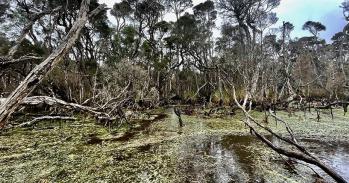
Researchers from the universities of Cambridge and Western Australia have uncovered the importance of hydrothermal vents, similar to underwater geysers, in supplying minerals that may have been a key ingredient in the emergence of early life.
Researchers from the universities of Cambridge and Western Australia have uncovered the importance of hydrothermal vents, similar to underwater geysers, in supplying minerals that may have been a key ingredient in the emergence of early life.
Their study, published in Science Advances, examined 3.5-billion-year-old rocks from western Australia in previously unseen detail and identified large quantities of a mineral called greenalite, which is thought to have played a role in early biological processes. The researchers also found that the seafloor vents would have seeded the oceans with apatite, a mineral rich in the life-essential element phosphorus.
The earliest lifeforms we know of—single-celled microorganisms, or microbes—emerged around 3.7 billion years ago. Most of the rocks that contain traces of them and the environment they lived in have, however, been destroyed. Some of the only evidence we have of this pivotal time comes from an outcrop of sediments in the remote Australian outback.
The so-called Dresser Formation has been studied for years but, in the new study, researchers re-examined the rocks in closer detail, using high magnification electron microscopes to reveal tiny minerals that were essentially hidden in plain sight.
The greenalite particles they observed measured just a few hundred nanometres in size—so small that they would have been washed over thousands of kilometres, potentially finding their way into a range of environments where they may have kick-started otherwise unfavourable chemical reactions, such as those involved in building the first DNA and RNA molecules.
“We’ve found that hydrothermal vents supplied trillions upon trillions of tiny, highly-reactive greenalite particles, as well as large quantities of phosphorus,” said Professor Birger Rasmussen, lead author of the study from the University of Western Australia.
Rasmussen said scientists are still unsure as to the exact role of greenalite in building primitive cells, “but this mineral was in the right place at the right time, and also had the right size and crystal structure to promote the assembly of early cells.”
The rocks the researchers studied contain characteristic layers of rusty-red, iron-rich jasper which formed as mineral-laden seawater spewed from hydrothermal vents. Scientists had thought the jaspers got their distinctive red colour from particles of iron oxide which, just like rust, form when iron is exposed to oxygen.
But how did this iron oxide form when Earth’s early oceans lacked oxygen? One theory is that photosynthesising cyanobacteria in the oceans produced the oxygen, and that it wasn’t until later, around 2.4 billion years ago, that this oxygen started to skyrocket in the atmosphere.
The new results change that assumption, however, “the story is completely different once you look closely enough,” said study co-author Professor Nick Tosca from Cambridge’s Department of Earth Sciences.
The researchers found that tiny, drab, particles of greenalite far outnumbered the iron oxide particles which give the jaspers their colour. The iron oxide was not an original feature, discounting the theory that they were formed by the activity of cyanobacteria.
“Our findings show that iron wasn’t oxidised in the oceans; instead, it combined with silica to form tiny crystals of greenalite,” said Tosca. “That means major oxygen producers, cyanobacteria, may have evolved later, potentially coinciding with the soar in atmospheric oxygen during the Great Oxygenation Event.”
Birger said that more experiments are needed to identify how greenalite might facilitate prebiotic chemistry, “but it was present in such vast quantities that, under the right conditions its surfaces could have synthesized an enormous number of RNA-type sequences, addressing a key question in origin of life research – where did all the RNA come from?”
Reference:
Rasmussen, B, Muhling, J, Tosca, N J. 'Nanoparticulate apatite and greenalite in oldest, well-preserved hydrothermal vent precipitates.' Science Advances (2024). DOI: 10.1126/sciadv.adj4789

The text in this work is licensed under a Creative Commons Attribution-NonCommercial-ShareAlike 4.0 International License. Images, including our videos, are Copyright ©University of Cambridge and licensors/contributors as identified. All rights reserved. We make our image and video content available in a number of ways – on our main website under its Terms and conditions, and on a range of channels including social media that permit your use and sharing of our content under their respective Terms.




